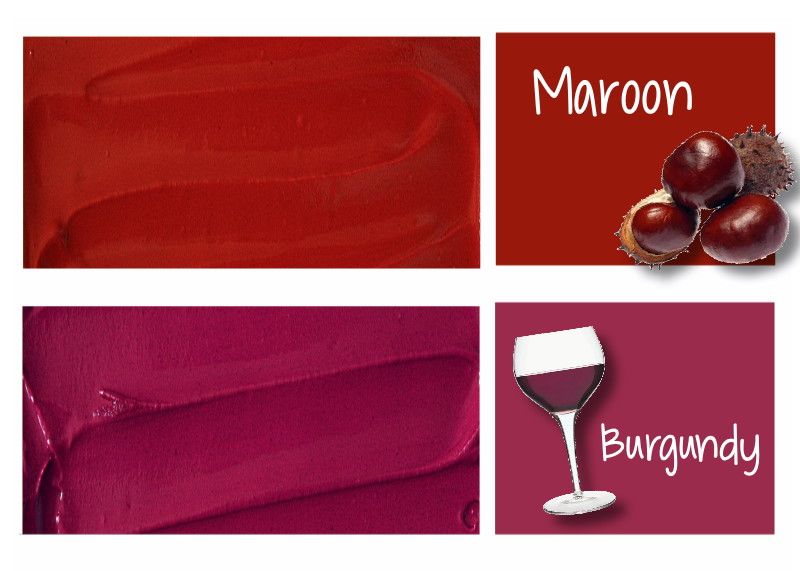Maroon and burgundy are both dark reddish-brown colors that look similar to the naked eye. However, there are distinct differences between the two shades. Understanding the nuances between maroon and burgundy can be useful for fashion, interior decorating, graphic design, and other applications where color is important.
This article will compare and contrast maroon versus burgundy across the following categories:
| Color Origins | HEX Codes |
| HSL & RGB Values | Use in Fashion |
| Use in Interiors | Psychology & Symbolism |
Examining these key differences will shed light on when to use maroon versus burgundy for best effect.
Color Origins
Maroon was first used as a color name in English in 1789, derived from the French word marron which means chestnut. Originally, the word referred to the reddish-brown color of chestnut shells.
Burgundy also gets its name from a French word, bourgeon, meaning bud or shoot. This refers to the color of red wine coming from Burgundy grapes.
So while both colors take their names from French words, maroon is related to nuts and burgundy is related to wine. This hints at slight differences in their hues.
HEX Codes
HEX codes are used to define digital colors. The HEX code for maroon is #800000. This code signifies a deep red color with no blue or green tones.
Burgundy’s HEX code is #900020. The higher value green and blue codes in burgundy give it a subtle purplish-red tone compared to the pure redness of maroon.
HSL & RGB Values
Looking at the HSL (hue, saturation, lightness) and RGB (red, green, blue) values of maroon and burgundy further differentiates their composed colors:
Maroon HSL & RGB
– Hue: 0 degrees
– Saturation: 100%
– Lightness: 25%
– Red: 128
– Green: 0
– Blue: 0
Burgundy HSL & RGB
– Hue: 344 degrees
– Saturation: 59%
– Lightness: 31%
– Red: 144
– Green: 32
– Blue: 32
As seen above, maroon has a 0 degree hue, meaning it contains only red and no other colors. Burgundy has a higher lightness level and over 30% green and blue mixed with red to create a subtle purple tint.
Use in Fashion
In fashion, maroon and burgundy are often used interchangeably as fall/winter colors. However, there are some guidelines on when to wear each shade:
– Maroon suits and darker maroon ties look great on men with dark complexions. Lighter maroon clothing works well for pale skin tones.
– Burgundy pairs nicely with grey and camel for a more elegant look. The purple undertones of burgundy complement fair skin best.
– Women tend to wear more burgundy than maroon. Burgundy dresses and heels look flattering and classy for special occasions.
– Dark burgundy coats are a stylish winter choice to stand out from the typical black wool coats.
– Maroon jeans are trendy and more casual. Maroon works for plaid shirts, t-shirts, and other everyday clothing items.
So in summary, maroon as a pure red is bolder and more casual, while subtle burgundy is considered more elegant and refined.
Use in Interiors
Both maroon and burgundy work beautifully in home interiors. Here are some tips on using each shade:
– Maroon makes a dramatic impact in small doses. Use it in lampshades, throw pillows, area rugs or accent walls.
– Paint built-in bookshelves or display cabinets maroon for a sophisticated library look.
– Burgundy has a luxurious feel. Upholster chairs or sofas in burgundy leather for upscale appeal.
– Layer burgundy and gold accessories on tabletops or mantels for a glamorous effect.
– Hang burgundy drapes or roman shades in a home office for a refined, focused feel.
– Use maroon in rooms designed for men or teens; burgundy works better for feminine spaces.
– Paint a front door maroon or burgundy for great curb appeal.
In decor, maroon injects energy while burgundy adds sophistication. Choose appropriately based on the mood you want to set.
Psychology & Symbolism
Maroon and burgundy also differ slightly in their cultural associations and symbolism:
– Maroon represents passion, strength, and courage. It’s the main color of Gryffindor house in Harry Potter.
– In the western United States, maroon symbolizes the earth and southwest landscapes.
– Maroon is associated with sacrifice and bravery. It’s used in medals and military decorations.
– Burgundy represents elegance, luxury, and prosperity. It’s the color of royalty, fine wine, and gourmet cuisine.
– In Hindu culture, burgundy corresponds to the Svadhisthana chakra, symbolizing vitality and creativity.
– Burgundy is also a tone of academia and prestigious universities. It’s seen in graduation gowns.
– In crystals and gemstones, burgundy-colored garnets symbolize truth and commitment.
So maroon conveys strength, courage, and sacrifice, while burgundy signifies refinement, luxury, and creativity. Both colors make bold statements.
Conclusion
While similar, maroon and burgundy have distinct difference when examined closely. Maroon is a pure red with no undertones, while burgundy mixes in blue and purple hues. Maroon leans causal, burgundy elegant.
Knowing this color vocabulary helps pick the perfect shade. Maroon stands out in minimalist rooms or everyday fashion as a bold accent. Subtly shaded burgundy adds sophistication and intrigue for major decor statements or formal attire.
Whether you’re making wardrobe choices or interior design plans, keep these comparisons in mind. Let desired mood, personal tastes, and practical applications guide you to maroon or burgundy for maximum visual impact.


